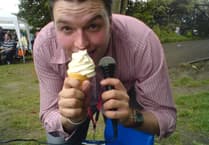
If you’ve spotted a wild bird with a ring around its leg, you may have wondered who put it there, when and why. Who might want to know where that bird is now?
Bird ringing – also known as banding – is a reliable and harmless way to identify individual birds. It involves placing a lightweight, uniquely numbered metal ring (“band”) around a bird’s leg.
When birds are caught again, ornithologists (scientists who study birds, rather than birdwatchers) gain essential information about where birds go after leaving our shores, how far they travel, if they return to the same breeding grounds and how long they live.
Reports of ringed birds (locations and dates) are how we know so much about long-distance bird migration, featured recently here in “Out and About”. Ringing is also invaluable in helping us understand how and why populations are changing.
If the corpse of a ringed bird is found, important information may be obtained about the life expectancy of the species and the spread of avian diseases.
Ringing isn’t cruel or harmful, although in certain situations it may be temporarily distressing to the bird while it is being caught and handled. There are no long-term after-effects and the ring doesn’t restrict movement.
The numbers on a wild bird’s ring are unique to that particular bird and registered with a bird ringing authority. The organisation covering all European schemes is called Euring: it defines the format (letters, numbers, colours etc.) shown on the ring. Euring delegates ringing in Britain and Ireland to the British Trust for Ornithology (BTO).
Only specially trained ornithologists – often working for or on behalf of wildlife charities and nature conservation organisations – are allowed to fit rings to wild birds In the UK. First, they need a licence issued by the BTO.
The data on every ring is stored on a central database which records the species, where and when it was ringed and any subsequent observation dates. When a bird is seen again, the ring details can be reported to the BTO online at https://app.bto.org/euring.
Mute swans are a special case. Mute swans on the Thames are ringed to denote their ownership if they belong to the Vintners or the Dyers livery companies; cygnets’ ownership is determined by their parentage. Unmarked mute swans and their cygnets are left unmarked.
By tradition, the Monarch can claim ownership of any unmarked mute swan swimming in open waters. This tradition dates back hundreds of years to when swans were a special food at banquets.
Unlike chickens, ducks and geese, swans can’t be fully domesticated and have to be taken from the wild, so they were reserved for the Monarch who could grant valuable rights of ownership to a favoured few.
The only organisation apart from the Vintners and Dyers allowed to own mute swans is Abbotsbury Swannery, which has owned swans since the 14th century. Some mute swans may be ringed by swan rescue and conservation charities for tracking them.
Racing pigeons are ringed under a system operated by various pigeon clubs and unions. The Royal Pigeon Racing Association’s website (www.rpra.org) is a good starting point if you would like to know more.
Non-wild birds, such as budgerigars and parrots kept by enthusiasts or as pets in the UK, may be ringed by breeders and owners. These systems are managed by enthusiasts’ societies: visit budgerigarsociety.com and theparrotsocietyuk.org for information.





Comments
This article has no comments yet. Be the first to leave a comment.